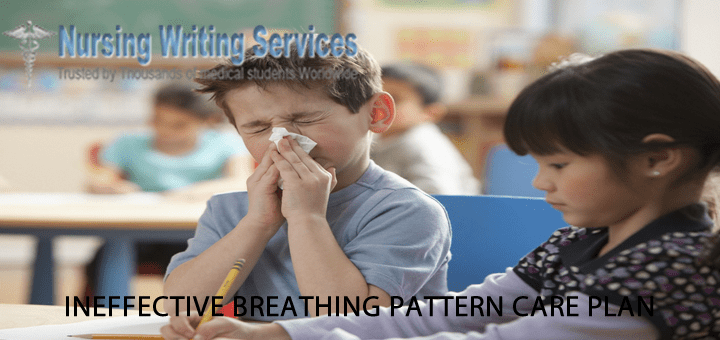
The ineffective breathing pattern is inspiration or expiration without providing adequate ventilation. It is the state in which the depth, rate, rhythm, and timing of breathing become altered. Ineffective breathing pattern could be the likely cause if abdominal wall excursion during expiration, inspiration or both fails to obtain optimum ventilation. Ineffective breathing pattern may deprive body cells of oxygen. This means that we should have proper ineffective breathing pattern care plan and Nursing Writing Services has the best writers in ineffective breathing pattern care plan writing services.
Ineffective Breathing Pattern Care Plan Diagnosis
Breathing pattern alteration might happen in different circumstances. For the care plan to be efficient, it is necessary that a caregiver checks for the correct signs and symptoms to prevent mistaken diagnosis.
- Altered check excursion
- Changes in depth and rate of respiration
- Leaning forward to breath
- Apnea
- Coughs
- Dyspnea
- Cyanosis
- Labored breathing and reliance on accessory muscles
- Increases metabolism, restlessness and apprehension
- Nasal flaring
- Noisy respiration
- Prolonged expiratory phase
- Pursed lip breathing
Ineffective Breathing Pattern Care Plan Goals and Outcomes
A care plan should have goals and outcomes that help the patient to achieve the following:
- Maintain an effective breathing pattern, at normal depth and rate without dyspenia.
- Retain respiratory rate within established limits
- Return of ABG level to established limits
- Carries out ADLs with regular breathing pattern
- Perform diaphragmatic pursed lip breathing
- Demonstrate maximum lung expansion and with adequate expansion
Ineffective Breathing Pattern Care Plan Assessment
Assessment is necessary to prove the existences of ineffective breathing pattern and establish the possible causes and ways of providing adequate care to the patient. It is essential for a caregiver to perform the following assessments.
Assess and record depth and respiratory rate: It is recommendable to assess the depth and rate or respiration at close intervals at least within 4 hours. The average respiration rate is 10 to 20 breaths a minute for adults. An alteration in breathing patterns requires the caregiver to take action and determine if the is respiratory compromise..
Assess ABG levels: Helps to monitor the status of ventilation and oxygenation
Determine if a patient has short breath: Factors affecting the patient such as anxiety may cause dyspnea. It is essential to watch if the patient is struggling to inhale much air at a go. To be air hungry shows that the reason for breath shortness in physical.
Check for the use of accessory muscle: Physiological causes of respiratory issues make the patient use accessory muscles and get air flow to the body. Signs include the use of the chest wall muscles, nostril flaring, and retraction of neck muscles.
Examine the skin color: Lack of oxygen causes the lips, fingers, and tongue to have blue /cyanosis.
Listen to breathing sounds: Wheezing, crackles absence of breathing sounds and other lung sounds are a sign of ineffective breathing pattern and need for help to determine interventions.
Check pulse oximetry: During the first assessment, the caregiver should the patient's oxygen saturation and regularly after the first check to monitor respiratory conditions. Normal oxygen saturation level is 95-100%.
Ineffective Breathing Pattern Care Plan Interventions and Rationales
Assist the patient to stay calm and breathe slowly
Demonstrate slow breathing techniques and passive exhalation. Deep inspiration increases oxygenation to prevent atelectasis. Controlled breathing also helps to slow respirations to tachypneic patients while prolonged expiration prevents trapping of air.
Schedule rest periods during physical activity
Anyone suffering from ineffective breathing should avoid over-activity because it increases shortness of breath. A caregiver should help the patient to pace events and ensure that there are adequate rests between strenuous tasks.
Encourage turning, coughing and deep breathing after 2 hours
These activities help to move the respiratory secretions to prevent pneumonia. If the patient has a tremendous amount of mucus that is prevention breathing, a caregiver can use check and back percussions as a way of breaking up mucus.
Teach the patient to use purse lip breathing and abdominal breathing
Pursing the lips and breathing out slowly improves ventilation
Help the patient to sit up
Sitting up by patients with dyspnea assists to open the lungs.
Ambulate the patient thrice a day
Ambulation is a form of care in which a caregiver gets the patient from bed to engage in a light activity such as standing or walking after a medical procedure such as surgery. Ambulation helps in breaking up and moving secretions to clear the airways.
Use a fan in the patient's room
Consult a dietician on diet modification
COPD might cause malnutrition that in turn affects breathing pattern. Taking nutritious meals strengthens the functionality of the respiratory muscles.
ineffective breathing pattern care plan writing services
Nursing Writing Services is a top-ranked writing company well-known for its reliable ineffective breathing pattern care plan writing services, we manage to write good care plans since our writers are skilled and well experienced in writing. We work with writers with masters and Ph.D. degrees in nursing to keep up high standard writing services. We have provided ineffective breathing pattern care plan writing services to many nursing students globally and all we get is a thank you feedback from our customers as they are happy with our writings.
In need of ineffective breathing pattern care plan writing services, order with us already, we work 24/7 and we take our customers orders with a lot of respect. We will make sure you get back your care plan paper in good time, clean free from plagiarism and grammar errors.



